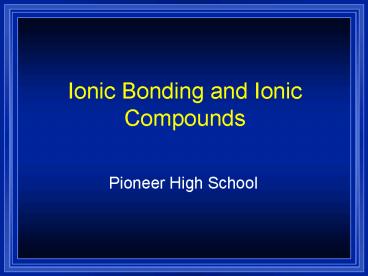Ionic Bonding and Ionic Compounds - PowerPoint PPT Presentation
1 / 35
Title:
Ionic Bonding and Ionic Compounds
Description:
Both malleability and ductility explained in terms of the mobility of the valence electrons ... corrosion resistant, ductility, hardness, toughness, cost. Why ... – PowerPoint PPT presentation
Number of Views:64
Avg rating:3.0/5.0
Title: Ionic Bonding and Ionic Compounds
1
Ionic Bonding and Ionic Compounds
- Pioneer High School
2
Chapter 8Ionic Compounds
- OBJECTIVES
- Explain the formation and properties of ionic
bonds.
3
Electron Dots For Cations
- Metals will have few valence electrons (usually 3
or less)
Ca
4
Electron Dots For Cations
- Metals will have few valence electrons
- These will come off
Ca
5
Electron Dots For Cations
- Metals will have few valence electrons
- These will come off
- Forming positive ions
Ca2
Pseudo-noble gas configuration
6
Electron Dots For Anions
- Nonmetals will have many valence electrons
(usually 5 or more) - They will gain electrons to fill outer shell.
P
P3-
7
Ionic Bonding
- Anions and cations are held together by opposite
charges. - Ionic compounds are called salts.
- Simplest ratio is called the formula unit.
- The bond is formed through the transfer of
electrons. - Electrons are transferred to achieve noble gas
configuration.
8
Ionic Bonding
Na
Cl
9
Ionic Bonding
Na
Cl-
10
Ionic Bonding
- All the electrons must be accounted for!
Ca
P
11
Ionic Bonding
Ca
P
12
Ionic Bonding
Ca2
P
13
Ionic Bonding
Ca2
P
Ca
14
Ionic Bonding
Ca2
P 3-
Ca
15
Ionic Bonding
Ca2
P 3-
Ca
P
16
Ionic Bonding
Ca2
P 3-
Ca2
P
17
Ionic Bonding
Ca
Ca2
P 3-
Ca2
P
18
Ionic Bonding
Ca
Ca2
P 3-
Ca2
P
19
Ionic Bonding
Ca2
Ca2
P 3-
Ca2
P 3-
20
Ionic Bonding
Ca3P2
Formula Unit
Sample Problems pg217 7-11
21
Properties of Ionic Compounds
- Crystalline structure, usually solids
- A regular repeating arrangement of ions in the
solid - Ions are strongly bonded together.
- Structure is rigid.
- High melting points
22
Crystalline structure
23
Do they Conduct?
- Conducting electricity is allowing charges to
move. - In a solid, the ions are locked in place.
- Ionic solids are insulators.
- When melted, the ions can move around.
- Melted ionic compounds conduct.
- NaCl must get to about 800 ºC.
- Dissolved in water they conduct (aqueous)
24
Bonding in Metals
- OBJECTIVES
- Use the theory of metallic bonds to explain the
physical properties of metals.
25
Bonding in Metals
- OBJECTIVES
- Describe the arrangements of atoms in some common
metallic crystal structures.
26
Metallic Bonds
- How atoms are held together in the solid.
- Metals hold on to their valence electrons very
weakly. - Think of them as positive ions (cations) floating
in a sea of electrons Fig. 15.13, p.427
27
Sea of Electrons
- Electrons are free to move through the solid.
- Metals conduct electricity.
28
Metals are Malleable
- Hammered into shape (bend).
- Also ductile - drawn into wires.
- Both malleability and ductility explained in
terms of the mobility of the valence electrons
29
Malleable
30
Malleable
- Electrons allow atoms to slide by.
31
Ionic solids are brittle
32
Ionic solids are brittle
- Strong Repulsion breaks crystal apart.
33
Alloys
- We use lots of metals every day, but few are pure
metals - Alloys - mixtures of 2 or more elements, at least
1 is a metal - made by melting a mixture of the ingredients,
then cooling - Brass an alloy of Cu and Zn
- Bronze Cu and Sn
34
Why use alloys?
- Properties often superior to element
- Sterling silver (92.5 Ag, 7.5 Cu) is harder and
more durable than pure Ag, but still soft enough
to make jewelry and tableware - Steels are very important alloys
- corrosion resistant, ductility, hardness,
toughness, cost
35
Why use alloys?
- Table 15.3, p.429 - common alloys
- Types? a) substitutional alloy- the atoms in the
components are about the same size - b) interstitial alloy- the atomic sizes quite
different smaller atoms fit into the spaces
between larger - Amalgam- dental use, contains Hg































